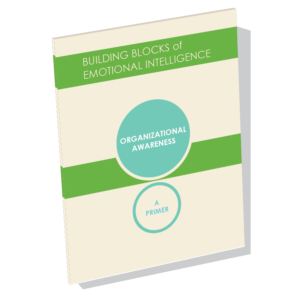

Organizational Awareness in Action
July 18, 2017 Time to read: 3 min.What does it look like when a leader is skilled in the Organizational Awareness Competency? Here are some examples I’ve seen in my work as a consultant and technology executive.
Communicating to Different Interests
One leader at an international financial institution understood the importance of communicating in a way that addressed the needs of different people in the organization. Each group has its own interests and “language.”
As the executive sponsor for a critical program, he realized that he needed to communicate to a wide array of players, each with their own perspective.
He crafted a message to the board of directors, considering their need for a high-level summary, the ability to delve into details as they saw fit, and a focus on profits and impact on the organization’s strategy. He crafted another communication for the shareholders of the company, considering their interests. Then, he addressed the nuances needed to communicate with the news media, the organization’s executives, leadership at the next levels, and the technologists, clerks, administrators, and other people doing the day-to-day operational activities needed to make the program a success.
Each communication was a true reflection of the program, though, at a level of detail, in a medium and language that was tailored to each role and highlighted issues and concerns relevant to each group.
A leader with organizational awareness uses his or her understanding of the nature of the relationships, hierarchies, and decision-making processes to communicate more effectively.
This leader knew that he was more likely to get buy-in from the various groups and individuals because he communicated in a way that resonated with them. He understood their values and how they made decisions. Buy-in then got him the funding he needed and gave him the ability to manage expectations in a more effective way. Therefore, he could be more successful and respected as a leader. That respect translated into greater effectiveness.
Communication is one primary element of organizational awareness. Another is the ability to take a systems and process view of the organization. The effective leader is able, on a day-to-day level, to resolve issues by focusing on their causes. This requires recognizing that those causes are rooted in the organization’s structure, policies, procedures and processes. Leaders skilled at organizational awareness have a greater sense of the bigger picture. They see issues in the context of the complex interactions among departments, individuals and competing values in play.
Navigating Change
As a consultant, I worked on a project with an international bank to reengineer the process they used to provide large-scale commercial loans to their clients. The bank’s leadership wanted a more automated system better control the bank’s global credit exposure. The organization dynamics we needed to deal with related to the business process as well as the information technology organization and its involvement.
There were a main IT department was responsible for technology applications for the bank’s central office and relatively autonomous IT departments in outlying regions – Europe, Asia, and Latin America. That meant there were siloed groups processing and managing credit related data in different ways.
Organizational awareness enabled us to see the potential for communication and decision-making difficulties between those different players in the IT world.
The bank’s leadership of the recognized that there were large personality and political differences between the IT departments and that it was impossible to reconcile those differences in the short-term. So, we crafted a solution that removed the program from the IT world and put it into a newly organized Product Management office. That office would define, design and manage the program and coordinate the efforts of all other departments, including the IT departments, and vendors involved. . The IT organizations were doing a great job individually, but coordination among them was contentious.
The product designers crafted an architecture that enabled continued autonomy among the groups, minimizing change in other business areas, while getting the desired result – comprehensive and accurate data that reflected the global exposure to families of companies, countries and industries. The IT folks could focus on what they do best, and we took the communication and coordination challenges off their hands.
The use of organizational awareness here prevented what could have been a failed program. Getting the IT silos to work together to design a new system to replace their existing systems would have taken years of tedious effort and a super-human facilitator. It is likely that compromises among the IT groups, known for vying with one another for control and influence, would have been sub-optimal. By Understanding the character and the different interests of each department, leaders created a solution that was embraced by all, and resulted in a cost effective, timely outcome.
Recommended reading:
 Our new primer series is written by Daniel Goleman, George Pitagorsky, and fellow thought leaders in the field of Emotional Intelligence and research. See our latest release: Organizational Awareness: A Primer for more insights on how this applies in leadership.
Our new primer series is written by Daniel Goleman, George Pitagorsky, and fellow thought leaders in the field of Emotional Intelligence and research. See our latest release: Organizational Awareness: A Primer for more insights on how this applies in leadership.
Additional primers so far include:







